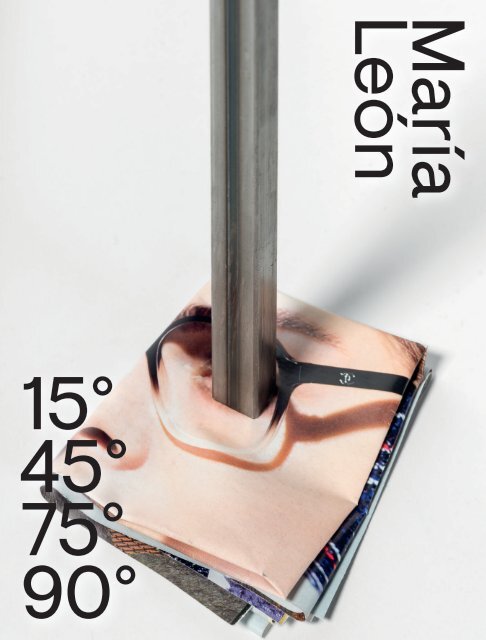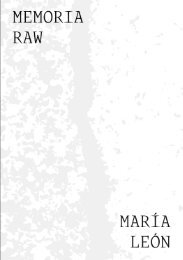Maria Leon 15º 45º 75º 90º
Goldrausch Künstlerinnenprojekt art IT, Berlin 2017, 16 pages, 30 x 23 cm, Softcover, English
Goldrausch Künstlerinnenprojekt art IT, Berlin 2017, 16 pages, 30 x 23 cm, Softcover, English
Create successful ePaper yourself
Turn your PDF publications into a flip-book with our unique Google optimized e-Paper software.
María<br />
León<br />
15°<br />
45°<br />
75°<br />
90°
NWIO, 2016<br />
installation detail
NWIO, 2016<br />
handmade paper from newspaper,<br />
relief engraving, newspaper clippings,<br />
paper paste, magazine sheet and iron structures<br />
dimensions variable
NWIO, 2016<br />
installation detail
emit ni tsol lost in time, 2014<br />
curtains modified with newspaper clippings<br />
dimensions variable
The Tyranny of Speed or,<br />
the Motor Peril and Its Remedy, 2016<br />
hubcap and newspaper<br />
dimensions variable
Sin título, 2016<br />
iron bars and piece of newspaper<br />
200 × 7.5 cm
Traces of Truths and the Mediated Surface<br />
Text Kate Brown<br />
At the peripheries of an iron frame, newsprint clippings<br />
dangle precariously, threatening to fall into the negative<br />
space that blooms between its perpendicular bars. María<br />
León’s sculpture »NWIO« could be an editor’s table, a<br />
skeletal remnant from a disaster or an apocalypse. Around<br />
the frame, information lingers on the edge of extinction.<br />
Largely dedicated to mining the formal and symbolic potentialities<br />
of newsprint media, the work of the Spanish artist<br />
investigates its own materiality by way of destruction and<br />
fragmentation, questioning the looming obsolescence of<br />
the medium itself. León’s works embody a profound quiet, as<br />
though they exist in the stillness of an aftermath.<br />
Aftermath of what, exactly? Take the current advertising catchphrase<br />
of the »Washington Post«: ‘Democracy dies in darkness.’<br />
Such dramatic words only begin to respond to the fears<br />
surrounding the perpetually uncertain now, as we wonder<br />
whether we are backing onto a cultural precipice. We cannot<br />
speak about recent years without eventually coming around<br />
to certain topics: what is fake or fact, vaudeville politicians,<br />
media blackouts, evidence denial, oppression of journalists.<br />
The news as an entity is in deep crisis, and its viewers are in<br />
a crisis of faith. As so much of what is seen and heard quivers<br />
on the brink of rumour and gossip, current media bodies call<br />
themselves into question; doubts circulate about both the<br />
form and content of news. In this landscape, there is urgency<br />
for artistic investigation into the structures that frame our notions<br />
of truth and traces of it, our cultural and political memory,<br />
and our projections of the future.<br />
León’s works orbit various facets of newsprint media, though<br />
not in isolation. Rather, she explores digitalism through printing<br />
and print processes. The digital screen and its flatness recur<br />
as metaphor, and a minimalistic language is woven across<br />
paper pulp and torn pages. The image as raw data or a summation<br />
of pixels can be seen in León’s treatment of images,<br />
where the newspaper becomes device. Articles are broken up<br />
into words or letters, almost like code. As with »The Tyranny<br />
of Speed or, the Motor Peril and Its Remedy«, the aesthetics<br />
of pace and progress overtake and digest old ways: an automobile<br />
hubcap is stuffed with a crumpled article, and another<br />
hubcap obfuscates the view of a folded-up tabloid format or<br />
a torn sheet.<br />
By implementing various techniques of post-production (editing,<br />
cutting, filtering, pasting, trimming and image correction)<br />
by hand, as opposed to using digital methods, León ensures<br />
that uncertainty pervades. The question continues to circulate:<br />
What is being lost? The artifice of digital language<br />
that León incorporates belies the tangibility of decomposing<br />
waste – the quintessence of a day-old newspaper. Components<br />
of each narrative are fragmented or erased. In the video<br />
work »Printing Press«, broadsheets run through the printer,<br />
our perception tilted at an unusual angle as images and text<br />
streak by in a blur of abstract colour and shape. The television<br />
hangs as if in an airport terminal or waiting room, the meaning<br />
of its content undecipherable. With »Deutsche Tageszeitungen«,<br />
León scratches out every piece of content on several<br />
printed pages with a ballpoint pen and then hangs them, as if<br />
to dry. Silhouettes of letters peer through, but just barely. As<br />
in »Layout«, where León creates her own pulp from recycled<br />
newspapers and bolts them together against the wall, we perceive<br />
flecks of ink. Through rather unlikely means the works<br />
recall Reductivist painting styles and Dadaist narrative-making<br />
through a lyrical nonsense built from miscellaneous words<br />
and image pieces.<br />
There is a subtle femininity to León’s studio processes and their<br />
outcomes. In the studio, she embraces elements of traditionally<br />
female practices that have been contained in the domestic<br />
domain. Images are cut, ordered, collected and archived in a<br />
manner reminiscent of scrapbooking, home décor and craft.<br />
Her works often begin this way, at an intimate scale, before<br />
being incorporated into larger sculptural forms. With »emit ni<br />
tsol lost in time«, León breaks an image apart and weaves it<br />
back together in new compositions on beaded curtains. Now<br />
adorned, each individual curtain can be draped and pulled<br />
into further forms. The negative space of the wall seems to<br />
reference a boundary between the private and public spheres,<br />
as the curtains engage in an almost flirtatious activity of<br />
showing and hiding. A welcome to strangers but a control for<br />
pests, these curtains might blow in the breeze, quiet and passive<br />
editors themselves.<br />
Newspaper is not a material built to last. It burns first and it<br />
burns quickly. It eradicates itself daily. It is a fragile thing with<br />
little archival integrity, and it does not fit easily into the canons<br />
of artwork. Yet, be it stories of war, unrest, discovery or<br />
scandal, everything newsworthy is comprised of small dots of<br />
CMYK on thin grey paper. It is a delicateness rendered invisible<br />
by the power of its content. María León is acutely aware<br />
of this contradiction within her practice, and by bringing it to<br />
light an interesting shift occurs. We understand how fragile<br />
information and content can be. We become aware of our<br />
desire for knowledge and our very human condition of curiosity.<br />
Simultaneously, we encounter a sense of loss. We feel<br />
deep disquiet as our collective memory is erased, the remainder<br />
unsettling yet picturesque.<br />
born 1984, Mérida, Spain // 2007 Bachelor of Fine Arts,<br />
Complutense University of Madrid / 2010 Master of Fine<br />
Arts, Complutense University of Madrid // 2011 »Kaunas<br />
Biennial Textile 11: Rewind-Play-Forward« // 2014 »Back to<br />
the Future«, Embassy of Spain, Berlin // 2015 »XVIII Bienal<br />
Internacional de Arte de Cerveira« // 2016 »14° Mostra Arte<br />
Gas Natural Fenosa«, Museo de Arte Contemporáneo,<br />
A Coruña / 2016 »CALL«, Luis Adelantado Gallery, Valencia /<br />
»Werkstoff«, Cruce Arte y Pensamiento, Madrid / Bilbao Arte<br />
Fundazioa Grant, Bilbao // 2017 »Goldrausch 2017«, Kunstquartier<br />
Bethanien Studio 1, Berlin / »EMBED_IMG«, Tenerife<br />
Espacio de las Artes, Tenerife<br />
María León
www.marialeon.net<br />
Imprint: »15° 45° 75° 90°«<br />
Published by Goldrausch Künstlerinnenprojekt,<br />
Goldrausch Frauennetzwerk Berlin e. V.,<br />
Händelallee 1, 10557 Berlin. A professional<br />
development programme for female visual artists<br />
funded by the European Union (European Social<br />
Fund) and the Berlin Senate Department for<br />
Health, Long-Term Care and Gender Equality.<br />
Project Direction Hannah Kruse<br />
Course Coordination Birgit Effinger<br />
Administration & Finance Kira Dell<br />
Project Assistance Nicola Schüschke, Janina Vujic<br />
Text Kate Brown<br />
Design Jenny Hasselbach, Rimini Berlin<br />
Copy Editing Sophie Perl<br />
EUROPÄISCHE UNION<br />
Europäischer Sozialfonds<br />
www.goldrausch-kuenstlerinnen.de<br />
Photography Jenny Hasselbach, María León,<br />
Nacho López (courtesy of Luis Adelantado Gallery)<br />
Image Editing Eberle & Eisfeld | Berlin<br />
Production Management Ellen Nonnenmacher,<br />
Berlin<br />
Printing Ruksaldruck GmbH und Co., Berlin<br />
© 2017 for this publication: María León<br />
and Goldrausch Künstlerinnenprojekt<br />
Published in conjunction with the exhibition<br />
»Goldrausch 2017«, 9–23 September 2017<br />
Studio 1, Kunstquartier Bethanien<br />
<strong>Maria</strong>nnenplatz 2, 10997 Berlin



